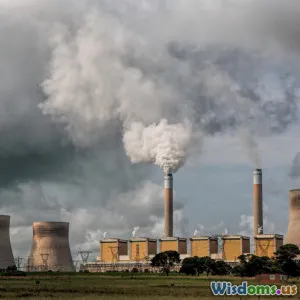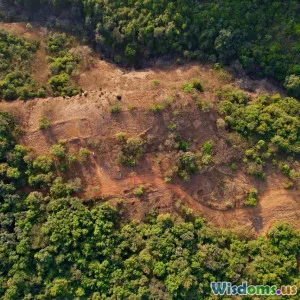
The Effects of Deforestation on Global Warming
8 min read Explore how deforestation accelerates global warming, its consequences, and the urgent need for sustainable forest management. (0 Reviews)
The Effects of Deforestation on Global Warming
Deforestation is often described as one of the major contributors to the accelerating pace of global warming. Yet, the intricate relationship between cutting down trees and the planet's rising temperatures remains misunderstood by many. Why does this happen, and what does it mean for the future of our environment? This article delves deep into the effects deforestation has on global warming, clarifying the science and highlighting the urgent need for action.
Understanding Deforestation: What’s at Stake?
Deforestation refers to the large-scale removal of forests, typically for agriculture, logging, infrastructure, and urban development. According to the Food and Agriculture Organization (FAO), approximately 10 million hectares of forest have been destroyed globally each year from 2015 to 2020. That is roughly the size of a country like Iceland disappearing annually.
Forests act as the Earth’s lungs. They absorb and store vast amounts of carbon dioxide (CO2), a greenhouse gas linked to global warming, and produce oxygen. When forests are cut down, two devastating things happen:
- The stored carbon is released into the atmosphere as CO2.
- The carbon-absorbing capacity of the ecosystem is reduced.
Together, these effects accelerate the greenhouse effect, leading to an increase in Earth’s average surface temperature.
The Carbon Cycle and Why Forests Matter
Forests naturally regulate the carbon cycle. Trees absorb CO2 during photosynthesis, converting it into biomass — leaves, trunks, and roots. Tropical forests, such as the Amazon, are especially powerful carbon sinks, storing an estimated 123 billion tons of carbon.
When these forests are destroyed, the carbon trapped within the vegetation and soil is released. This process contributes to about 10-15% of global greenhouse gas emissions, a figure comparable to emissions from the global transportation sector.
For example, the burning and logging of Amazonian forests release significant amounts of carbon annually, contributing directly to climate change. The IPCC (Intergovernmental Panel on Climate Change) reports indicate that deforestation emissions could undermine efforts to limit global temperature rise to 1.5°C, worsening climate impacts worldwide.
Albedo Effect and Local Climates
Deforestation doesn’t just cause carbon emissions; it also changes the Earth's surface properties, influencing local and global climates.
The loss of forest cover changes the albedo effect — the measure of how much sunlight the Earth's surface reflects. Forests tend to absorb sunlight, whereas cleared land reflects more, which could theoretically cool the surface. However, the net impact usually exacerbates warming because forests also contribute to moisture recycling via evapotranspiration, helping to cool the atmosphere.
In tropical regions, deforestation leads to reduced rainfall and drier climates. For instance, studies on Southeast Asia reveal significant declines in precipitation and increased regional temperatures tied directly to widespread forest loss.
Loss of Biodiversity Linked to Climate Regulation
Alongside carbon storage, forests provide habitats for the majority of terrestrial species. Their destruction results in biodiversity loss, which compromises ecosystem resilience — the ability to absorb and recover from environmental stresses.
Healthy biodiversity supports carbon sequestration in several ways. Different species contribute uniquely to soil quality, nutrient cycling, and plant growth dynamics. Therefore, deforestation not only increases carbon emissions but also diminishes nature’s capacity to mitigate ongoing climate change.
Deforestation Drivers: A Global Overview
Understanding why deforestation occurs helps us appreciate the challenge of mitigative efforts. The primary drivers include:
- Agricultural Expansion: Often to produce soy, palm oil, and cattle feed — critical commodities driving economic growth yet implicated in large forest losses.
- Logging: Both legal and illegal logging contribute to forest degradation.
- Infrastructure Development: Roads, urban sprawl, and mining operations fragment forests and create access points leading to further clearing.
Countries with the largest annual deforestation rates include Brazil, Indonesia, Democratic Republic of Congo, and Malaysia — regions rich in tropical rainforests and biodiversity.
Success Stories and Hope: The Path Toward Sustainable Solutions
While deforestation continues, there are inspiring examples where proactive measures have slowed or reversed trends.
-
Brazil’s Amazon Protection Initiatives: Between 2004 and 2012, deforestation rates in the Brazilian Amazon dropped by over 80%, attributable to satellite monitoring, law enforcement, and indigenous land rights. Although recent years have seen some backsliding, lessons from this period reinforce the importance of governance and community involvement.
-
Reforestation Programs: Countries like China and India have implemented large-scale tree planting programs, restoring degraded landscapes and creating carbon sinks.
-
Zero-Deforestation Supply Chains: Several multinational corporations in the palm oil, beef, and soy industries commit to zero-deforestation policies, emphasizing sustainability.
What Can Individuals and Policymakers Do?
Addressing deforestation requires a multi-faceted approach:
-
For policymakers: Implement stringent regulations, incentivize sustainable land management, and strengthen monitoring to combat illegal logging.
-
For consumers: Support products certified by organizations such as FSC (Forest Stewardship Council) or RSPO (Roundtable on Sustainable Palm Oil) that promote sustainable forestry.
-
Awareness and activism: Public pressure can encourage corporations and governments to adopt greener policies.
Conclusion: Deforestation and Global Warming — An Urgent Call for Action
The effects of deforestation on global warming are profound and multifaceted. Every hectare of forest lost is a harbinger of increased carbon emissions, diminished biodiversity, and disrupted climate patterns. Protecting and restoring forests is undeniably one of the most effective ways to fight climate change. As a society, understanding the stakes and championing sustainable practices is imperative to safeguard our planet for future generations.
Tree conservation is not merely about saving trees — it's about preserving the very air, climate, and ecosystems essential to life.
References:
- Food and Agriculture Organization (FAO), Global Forest Resources Assessment 2020
- Intergovernmental Panel on Climate Change (IPCC), Special Report on Climate Change and Land (2019)
- Nepstad, D. et al., "The role of forests in mitigating climate change" (PNAS, 2014)
- WWF, "Deforestation and Climate Change"
- Global Forest Watch data portal
Rate the Post
User Reviews
Popular Posts





















